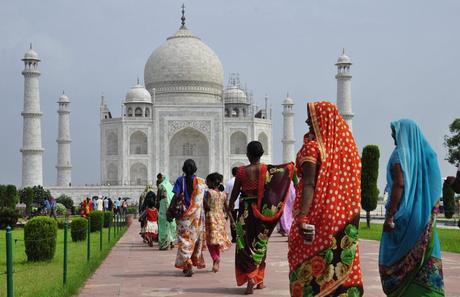
Language
Hindi is the official language, but English is widely understood throughout India.
Airlines, trains, telecommunications counters, and offices are all likely to have English-speaking staff. The majority of direction signs also include an English translation. Words in Indian English by S. Muthiah may be useful for visitors who want to figure out how local terms and grammar have been modified.
Religion
India is a secular state with a wide range of religious beliefs. Although the dominant religion in India is Hinduism, Islam, Christianity, Sikhism, Buddhism, Jainism, and Judaism are also followed. Some regions may be off-limits to tourists who do not practice the faith; taking photographs there might also be prohibited.
Currency
The Rupee and Paisa (100 Paisa equals 1 Rupee) are the official currency of India. Paper money is available in denominations of Rupis 10, 50, 100, 200, 500, and 2000. The coins come in values of Rs 1, 2, and 5.
Money Matters
The following are the restricted items that individuals from outside of India can bring into India:
1. The maximum amount of Indian Rupees that can be sent is 25,000.
2. Foreign currencies : limitless. However, cash in excess of USD 5,000 (or equivalent) or traveler's cheques in excess of USD 10,000 must be declared. Only banks and authorized money exchange points may be used for re-exchange. Use authorized moneychangers to exchange foreign currency; you run the danger of receiving counterfeit rupees or being scammed. In most cases, exchanging facilities are accessible at airports as well as at major hotels and authorized moneychangers usually display the rates of exchange. Credit cards are widely accepted in major hotels, restaurants, and retail outlets.
Tipping
It is not customary to tip, but it is appreciated.
Weather
The best time to visit India is during the winter season, from October to March, when weather conditions in most areas of the country are very pleasant. The months of September and April, when temperatures are warm with cool nights, are also a nice time to vacation.
The month of October is highly popular among tourists, particularly those visiting India. The country's vibrant fairs and festivals, which occur throughout the month, are a big draw for visitors. Dussehra and Diwali, two important Hindu holidays that take place in October or November, are celebrated with great enthusiasm. In November, the Pushkar fair in Rajasthan draws people from all over the world to celebrate the end of winter. Holi, India's colorful festival of springtime joy and exuberance, takes place in March and may be best experienced in either Jaipur or Jodhpur.
India's summer months are from May to June, when the country experiences its highest temperatures. This is the time to go into one of the several lovely hill stations. Adventure activities such as trekking, paragliding, and fishing may be found in some of these chilly retreats. Summer is India's "lean season" for tourism, so most services are at bargain prices.
The monsoons hit the Indian subcontinent in late June, bringing with them a cooling spell. The monsoon season typically lasts from July to August. While other regions of India, such as Ladakh and neighboring Himachal Pradesh, receive less precipitation than usual between mid-October and late December, the south-eastern region receives most of its rainfall during this period, allowing visitors to trek through the area.
Clothing
India may be a fun destination, but you'll need to dress appropriately for your journey. The dress code for your trip to India is comfortable-casual. We propose light and breathable layers to add and take off as needed, given the variances in temperature: it can get chilly in the car and at night, but it will become sweltering during the day.
- T-shirts and tops made of cotton
- Sandals are not advised for certain sightseeing excursions. Some sightseeing activities may necessitate the use of closed shoes or hiking boots.
- When exploring in towns and cities, lightweight pants, loose skirts or trousers, and at least short-sleeved clothing are suggested for men and women.
- Evening dining in city eateries may be done in somewhat smarter, but still casual, clothing. Formal wear is not required. Carry a sweater or light jacket with you if you'll be visiting an air-conditioned restaurant.
Men and women must cover their arms, legs, and shoulders when visiting temples, mosques, and other religious sites. If you're going to a religious site without shoes on, bring socks. When entering a religious building, remove your shoes so that you don't get bare-footed.
Pack your swimsuit; many hotels around offer swimming pools. Also bring sunglasses, sunscreen, and a sunhat. Lightweight binoculars are useful for sightseeing as well as wildlife viewing because they don't require much power. If the electricity goes out in the area, a tiny flashlight can come in handy. An extra pair of eyeglasses or contact lenses is recommended if you wear them (or you will be without them).
Health
Please contact your doctor for up-to-date information on current health and vaccination recommendations.
Electricity
220 volts and 50 hertz are the alternating current (AC) voltage and frequency of India.
Cell phones, cameras, and laptops don't usually need a converter; however, other devices might require a socket adaptor or voltage converter. Please verify the operation instructions for your equipment to ensure it is compatible with either 110 volts or 220 volts of electricity.
Photography
Only shoot a public scene with a lot of people if you have permission (the only exception is when photographing a public event with no specific aim at anyone). Always be considerate of those who don't want to be photographed. If you're using a video camera, most monuments are accessible.However, certain sections of some monuments are not allowed for photographs. Tripods and flash guns may be prohibited in specific situations. Photography is not permitted in a number of locations, and these sites are often clearly designated. Hindus are wary of death, therefore it's against their religion to photograph gods or inside temples. It is also against the law to take pictures at funerals or cremations.
Please keep in mind that video filming is expressly prohibited at airports, railway stations, and certain government buildings. Do not snap photographs of uniformed military or police personnel. If you're unsure, ask.
Local Customs
In India, the right hand is used for eating with and shaking hands, while the left hand is utilized for personal cleaning. It's considered rude to pass or accept things, or point at someone with your left hand. Kisses and hugs should not be performed in public areas; couples should avoid touching in more conservative rural regions.
Local Food
India's cuisine, although spicy, is not always extremely spicy. There are significant cultural and religious variances in food, but many meals are based on rice or another grain, accompanied by meat and/or vegetables cooked in a spiced sauce. Condiments and pickles ranging from sweet to sour to hot are served with most dishes, as well as dairy products including yogurt, butter, and soft cheese. India has a robust vegetarian food culture and several traditional (very rich and sweet) desserts. In India, even in hotel restaurants, reservations for dinner are required anytime you dine alone.

